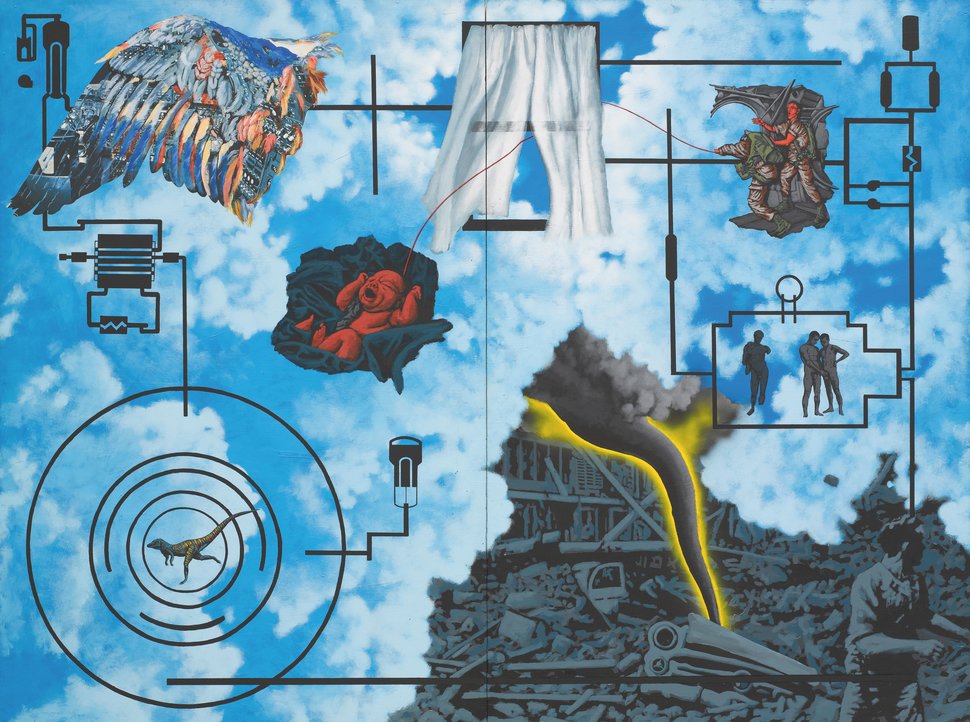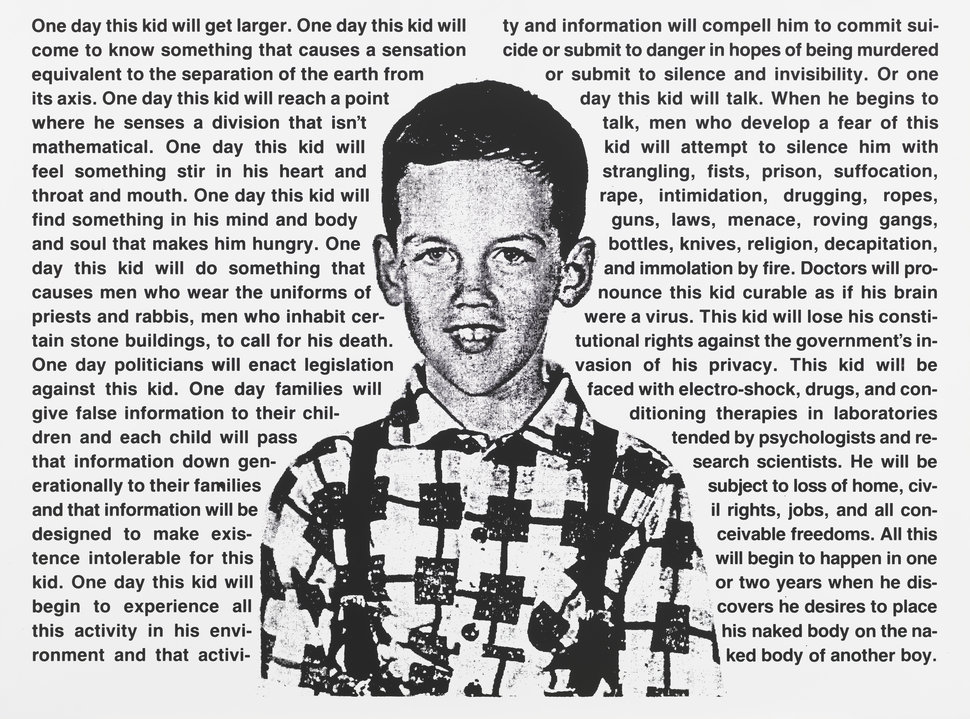[ad_1]
NEW YORK ― A now-iconic photo from 1988 reemerged on social media this year. It shows a man, his back turned to the camera, wearing a denim jacket that bares the words “If I die of AIDS ― forget burial ― just drop my body on the steps of the FDA.”
It was taken during a protest of the Food and Drug Administration, the organization that failed to take immediate action during the AIDS crisis that ripped Reagan-era America apart. In March, the photo appeared in a tweet alongside a more recent image of a Washington, D.C. student’s poster protesting gun violence in the U.S. The sign read, “If I die in a school shooting, drop my body on the steps of the CDC.”
The man in the original photo is American artist David Wojnarowicz, who died of AIDS-related complications in 1992. During his lifetime, he wielded art like a weapon. Its target: what Wojnarowicz dubbed the “pre-invented world,” the colonized and corporatized American mainstream that subjugated the powerless.
At the height of his career, Wojnarowicz was famous enough to have one of his images ― of buffalo stumbling off a cliff to their death ― appear on the cover of a U2 album. But the bulk of his art boasted less massive appeal. It became the subject of right-wing attacks from the American Family Association. It was deemed too caustic for traditional art institutions like the Smithsonian.
Indeed, many of Wojnarowicz’s works were made for expressing uncensored rage at a government and populace that refused to confront injustice. In his photos, paintings, performance and video, mouths appear crudely sewn shut and dead bodies confront the viewer head-on. Like a visual alternative to screams or sirens, his art pierced through our nation’s mythic veneer of civility, exposing the brutalities beneath its surface. For outsiders like Wojnarowicz ― working-class, queer, uneducated and HIV-positive ― good manners and politesse were deadly illusions.
Today, a quarter of a century after his death, Wojnarowicz’s two-fisted approach to protest feels familiar. Trump-era movements like Black Lives Matter and Everytown stoke the burning questions Wojnarowicz posed throughout his 15-year career: Do the lives of the vulnerable have value? Should speaking truth to power be limited by the rules of civility?
And his legacy within the art world feels stronger than ever: Wojnarowicz’s work currently appears at New York City’s Whitney Museum of American Art in an exhibition all its own. Set inside the pristine, white-walled space, his retrospective offers other questions: In an era of renewed unrest, what is the role of art? How severe must an image be to spark action?

Image courtesy of the Estate of David Wojnarowicz and PPOW New York
The first piece in “David Wojnarowicz: History Keeps Me Awake at Night” is a self-portrait, in which the left half of his face is collaged over with the scraps of maps and the right half of his body is on fire. A globe rests on his bicep like a tattoo. Nearby, a small cartoon man subsumed by flames plunges through white space, like he hurled himself from a catastrophe doomed to total destruction.
When I saw the self-portrait in person earlier this month, I felt a buzz in my pocket. It was a push alert from The New York Times. “Some children didn’t recognize their mothers at the court-ordered reunions of migrant families, after being separated for months,” it read. The sickening news, alerting Americans to the most recent horror in a seemingly bottomless succession of ethical lows, hints at why Wojnarowicz’s exhibition has been described as “timely,” “astonishingly relevant” and “urgently important.”
Wojnarowicz, born in 1954 in Red Bank, New Jersey, endured an “almost Dickensian” childhood, as biographer Cynthia Carr put it. His father was an alcoholic whose abuses include feeding Wojnarowicz and his siblings the family’s pet rabbit, claiming the meat to be lamb one day and steak another. Wojnarowicz’s parents divorced when he was 2, and after years of temporary homes and domestic upheaval, Wojnarowicz landed in a Hells Kitchen apartment with his mother.
By the time he was a teenager, he was immersed in the hustle of the New York streets. He used heroin, traded sex for money and cruised for men on the city’s derelict piers. In art, Wojnarowicz found a source of comfort and power amid chaos. As a teenager, he scrounged pennies to buy supplies, supplementing them with discarded objects he could turn into material, like trash can lids and supermarket posters.
Wojnarowicz barely scraped by in high school and never attended college, instead educating himself by reading Arthur Rimbaud, William Burroughs and Walt Whitman. In his 1979 series “Rimbaud in New York,” Wojnarowicz enlisted friends to pose around the city wearing a mask of the poet’s face ― making Rimbaud’s iconic line “I is another” into flesh.
In the early 1980s, his DIY projects displayed contempt for the finer art establishment. He left a pile of cow bones outside Leo Castelli’s swanky gallery, unleashed a swarm of cockroaches (dressed up as bunnies with miniature ears and tails) during an opening at the Museum of Modern Art’s PS1 outpost and commissioned artists to revamp neglected piers and warehouses on Manhattan’s West Side. He dubbed one site, the Ward Line Pier, “the real MoMA.”

Collection of the Second Ward Foundation
Before long, Wojnarowicz fell in with the East Village art scene, befriending Keith Haring, Nan Goldin, Jean-Michel Basquiat and Kiki Smith. He found popularity in the mainstream art world, though he was often fetishized as a “queer artist.” He regarded the art world gatekeepers with suspicion in return.
“He was like someone on fire,” Smith explained of Wojnarowicz in an interview. “Or maybe, it was that he had a fire inside of him.”
His work communicated as much, combining the accessible feel of a comic book with the sensory haze of a half-retained nightmare. Repeated images of fiery explosions, black brains, oversized ants, nuclear power plants, railroads, maps, currency and partially dissected frogs contributed to an epic mythologizing of our encroaching end of days. His canvases pieced together ornate conspiracies leading toward a single, inarguable conclusion: The world is on fire. Either we jump ship, or get comfortable living in hell.
At the Whitney, the message is the same in 2018 as it was in 1983: Everything is on fire. But aside from rage, queer desire was a crucial ingredient in Wojnarowicz’s art. Whereas many of the male artists before him gravitated toward sexualized images of women, Wojnarowicz explored the beauty and power of the erotic male body. In the 1982 work “Peter Hujar Dreaming/Yukio Mishima: St. Sebastian,” Wojnarowicz presents photographer Hujar, his mentor and former lover, reclining with his eyes closed in a state of reverie. Above him, Japanese author Yukio Mishima hovers as if in a dream, mid-masturbation. The entire image is subsumed by the torso of Saint Sebastian, daring the viewer to revel in the Christian martyr’s seductive shape.
Animals are another repeated element of Wojnarowicz’s visual world, representing the ultimate vulnerable “other” crushed by the power-hungry mainstream. Smith recalled how, in the 1980s, Wojnarowicz would buy and steal animals from New York pet stores, only to release them into the relative wilds of Central Park. One of the most moving pieces in the current Whitney show is a 1990 photograph of a hand cupping a small frog, whose entire body can fit within a single finger pad. Text in the upper right corner begins, “What is this little guy’s job in the world? If this guy dies, does the world know?”
In 1988, Wojnarowicz was diagnosed with AIDS, intensifying the indignation and desperation in his work. “Every painting or photograph or film I make, I make with the sense that it may be the last thing I do,” the artist wrote. To combat a culture that thought it easier to look away from the AIDS crisis than confront it, Wojnarowicz worked to make that impossible. His work burrowed itself into the deepest recesses of the viewer’s skull.
Few works demonstrate this more than Wojnarowicz’s 1987 portraits of Hujar, taken in a hospital room just moments after the photographer died of AIDS-related causes. Quiet, black-and-white images depict Hujar’s feet, hands and face ― slack-jawed, eyes askew, looking more like a receptacle of life than a manifestation of it. “His death is now as if it’s printed on celluloid on the backs of my eyes,” Wojnarowicz said, and he was determined to make others feel the same.
Wojnarowicz also protested with ― and created imagery for ― activist coalition ACT UP (AIDS Coalition to Unleash Power). On Thanksgiving in 1988, ACT UP held a protest at Trump Tower, lambasting the lack of housing available to people living with AIDS, while the city continued to give tax breaks to affluent developers like Trump. (Whether Wojnarowicz himself was at this particular protest is uncertain.)
Eventually, the United States government, FDA and Center for Disease Control and Prevention (CDC) acknowledged the magnitude of the AIDS crisis and took action to curtail it. For those in the thick of the disease’s carnage, however, these measures came too late. By the time President Bill Clinton hosted the first White House Conference on HIV/AIDS in 1995, 500,000 cases of HIV/AIDS had been reported in the U.S., making it the leading cause of death for Americans between 25 and 44.

Courtesy of The Estate of David Wojnarowicz and PPOW Gallery New York NY
American life has changed since Wojnarowicz’s death in 1992, though not in the ways he would have liked. “There is more despair, disparity and discrepancy now than before,” Smith told me.
Debates over whose lives have value continue to rage on, with immigrants, black people, trans people, children, LGBTQ people and women still fighting against policies that marginalize them. As to whether or not those people have a responsibility to remain civil as they object to the family separation policies wreaking havoc on children’s lives, the lack of gun control regulations that open the door for atrocities, and other egregious violations of human rights, Wojnarowicz’s work presents an unwavering answer.
“I’m waking up more and more from daydreams of tipping Amazonian blowdarts in ‘infected blood’ and spitting them at the exposed necklines of certain politicians,” the artist once said.
To Wojnarowicz ― whose ashes were valiantly scattered on the lawn of the White House ― civility is the insidious cousin of silence, and silence = death.
Smith guesses that Wojnarowicz would have had mixed feelings about his ongoing exhibition. Visitors at the Whitney might feel the same, quietly shuffling through a show that so painfully alludes to our contemporary cultural wounds, festering with a rancor even Wojnarowicz might not have anticipated. Museum shows are well and good, but they primarily serve the populations already spared from the impending wreckage. As a result, art can feel insular, bourgeois, insufficient in such a moment.
And yet, Wojnarowicz believed art could be an X-ray machine, helping us see through the myth of American greatness to spot the rot beneath and feel compelled to eradicate it. In a news cycle that is both exhausting and heartbreaking, Wojnarowicz’s work still urges people not to look away. But of course, that’s only the beginning. Wojnarowicz knew seeing wasn’t enough.
“There are a few people that can represent generations,” Smith said. “David is like that. He had that ability to witness and inspire.”
“David Wojnarowicz: History Keeps Me Awake At Night” is on view at New York’s Whitney Museum of American Art until Sept. 30.
[ad_2]
Source link

